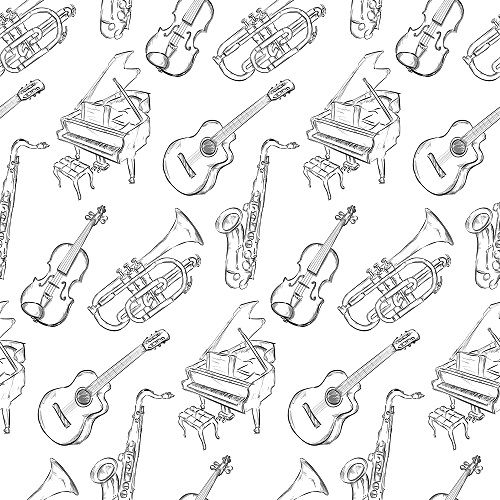Music Theory Basics Part 3
Chord Progressions
Now that you know about Major Scales and how to build Chords, let’s put the two together and discuss Chord Progressions.
Let’s take the key of C Major.
C D E F G A B
Most popular songs use only the notes from its key. Sometimes other notes outside the key are introduced, but we’ll discuss that later on. For now, we’ll just be talking about the 7 notes in C Major. If you build basic 3-note chords using only these notes, a pattern emerges:
I – C E G
ii – D F A
iii – E G B
IV – F A C
V – G B D
vi – A C E
viio – B D F
Roman numerals are most often used to designate the chords within a chord progression, with I being the chord built off of the Root, or the first note of the Major Scale. You’ll see that this chord, along with the IV and V chords are always Major due to the notes available to them. You’ll also notice that the ii, iii, and vi chords are Minor (lowercase Roman numerals are used for Minor chords) and the vii chord is Diminished.
The Magic Chord Progression
I – vi – IV – V
You would be surprised how many popular songs only use 4 chords (some even just 3!). The vast majority of them use the Major I, IV, and V, plus the Minor vi. Try playing these on your piano, guitar, or arpeggiating them on your melodic instrument. It’s the most used progression of the 20th century till now. Even before, this progression can be found as early as the Renaissance. While this order (I-vi-IV-V) is very common, any order of these chords is common. Try to see how many songs you can find that use only these chords!
Each chord also has a general function – I is the chord that determines the key of the song. It is used as a starting place, a release of musical tension, and an ending place. The IV chord is used as a lift usually from the I or the vi chord. It’s common in church music as the “Amen” chord, before resolving to the I. The V chord is a tension chord that resolves to the I – though occasionally it goes to vi, which is known in classical music as a “deceptive cadence”. The vi chord, being the only minor chord in this progression, is often used to add drama – the human mind subconsciously hears minor chords as “sad” and major chords as “happy” – something I will talk about in a later blog post.
ii and iii
The minor ii and iii chords aren’t quite as common, but they do come up quite a bit. Often the ii chord is used as a substitute for IV, as it shares two common tones. It also often is followed by the V chord. The iii chord is usually used to create movement to the IV on half step above, or the vi chord.
viio Diminished
The viio diminished chord (o is shorthand for Diminished, as noted in the previous blog post) is rarely used, as it often works better to use a V7 chord, which is essentially a vii plus a 5th scale degree. Though when it does come up, it’s usually preceding a III chord – which is a iii chord turned into a Major buy raising the 3rd of the chord.
Chords with Notes Outside of the Scale/Key
Sometimes composers will substitute chords that have a note or two outside of the key to create more tension, which is usually resolved back into the key on the next chord. Here’s the most common:
Major II, III, VI
The ii, iii, and vi chords are sometimes played as Major chords. By raising the 3rd degree of the chord, one can create a tension note that leads up a half-step to the chord a 4th degree above (II – V, III – vi, VI – ii). Often these chords will be found in old-time jazz and classic Broadway tunes, such as I Got Rhythm and All of Me (not John Legend’s song of the same name! His “All of Me” lands squarely in the I – vi – IV – V pop progression)
Minor iv
Sometimes the minor iv is used as a tension chord to move back to I. It adds a little melancholy sadness to a resolution. The Beatles’ song In My Life and Radiohead’s Creep use this chord very effectively.
Adding the 7th
Almost any of these chords can have the 7th added – the V7 being used quite often. The 7 is usually added within the key, which makes the I and VI chords Major 7 (I7 and IVM7), the V chord a Dominant or regular 7 (V7) and the minor chords become minor 7 (ii7, iii7, vi7). The diminished viio becomes Half-Diminished (viiø7). Sometimes, though, the I and IV chords (and even the major II, III, and VI) are altered to become Dominant 7 chords (I7, II7, etc…) to create even more tension, usually again to resolve to the chord a 4th degree above as discussed above.
On my next Music Theory blog, I’ll discuss Minor scales, their variations, and the chord progressions that are used with them. For now, try out this attached exercise in Harmonic Analysis!

